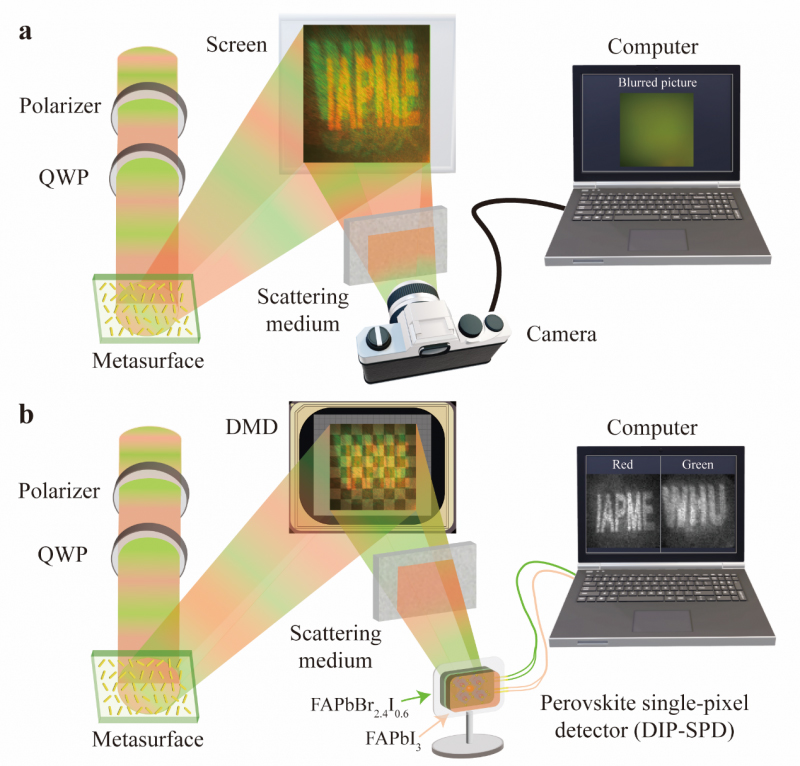| Feb 07, 2024 |
Perovskite single-pixel detector for efficient extraction of meta-images in complex environments
(Nanowerk News) Information technology plays a pivotal role in contemporary society, influencing aspects such as social communication, audio-visual entertainment in daily life, and the integration of cloud computing and the Internet of Things in industrial production. These scenarios are intricately linked to information technology.
|
|
Integral to information technology, the processing of information data is highly emphasized. The massive information data has prompted people to explore more effective methods of data storage and extraction. Among the numerous schemes, metasurfaces show great potential in information storage due to their modulation for different degrees of freedom of light. However, providing compact and efficient detectors for relevant multidimensional data retrieval remains a challenge, especially in complex environments.
|
Key Takeaways |
|
Advancements in information technology, particularly in data storage and extraction, highlight the importance of metasurfaces for information storage.
A new dual-color metasurface image extraction system utilizing a double-layer single-pixel detector offers efficient image retrieval without the need for additional filters.
This innovative system can accurately extract images in complex environments, overcoming challenges posed by scattering media and background light.
The technology demonstrates significant improvements over conventional image extraction methods, providing rapid, filter-free image capture of stored information at different wavelengths.
Future developments may enable full-color image extraction with a three-layer single-pixel detector, expanding applications for perovskite materials in color imaging.
|
 |
| a Schematic diagram of the commercial camera imaging of the superimposed dual-color images reconstructed by the metasurface in the presence of a scattering medium. b Schematic diagram of the DIP-SPD single-pixel imaging of the superimposed dual-color images reconstructed by the metasurface in the presence of a scattering medium. QWP: quarter-wave plate; DMD: digital micromirror device. (© Light Science & Applications)
|
The Research |
|
In a new paper published in Light Science & Applications ("Perovskite single-pixel detector for dual-color metasurface imaging recognition in complex environment"), a team of scientists, led by Professor Hong-Chao Liu from Institute of Applied Physics and Materials Engineering, University of Macau, Macao, and co-workers have introduced an efficient scheme for the extraction of dual-color metasurface images.
|
|
They devised and fabricated a double-layer single-pixel detector utilizing perovskite thin films with distinct compositions. Subsequently, they established a single-pixel imaging (SPI) system based on this detector. Leveraging the wavelength-selective properties inherent in perovskite devices, along with their high detection sensitivity, the system proficiently extracts images corresponding to different wavelengths from overlapping dual-color metasurface images in a single round measurement.
|
|
More interestingly, when combined with the distinctive advantages of single-pixel imaging, this system accurately extracts images of the target color even in complex environments that include scattering media and background light. The designed single-pixel imaging system streamlines the process of extracting images of various colors. With this dual-color images extraction system, there is no necessity for additional filters to segregate different wavelengths, thereby reducing both the cost of system components and the time required for image extraction.
|
|
The core of the dual-color metasurface images extraction system lies in the double-layer integrated perovskite single-pixel detector and the single-pixel imaging modality. The upper device of the detector is designated for the absorption of optical signals within the wavelength range of 300 - 600 nm, serving a self-filtering role. Meanwhile, the lower device is utilized to respond to optical signals within the wavelength range of 600 - 820 nm. These two layers collaborate to extract two images of different colors from overlapping dual-color metasurface images in a single round measurement.
|
|
Furthermore, the single-pixel imaging modality broadens the application scenarios of the dual-color image extraction system, enabling the extraction of clear target images in environments containing scattering media and background light.
|
|
These scientists compared their work to other existing images extraction schemes:“Compared with conventional proposals that utilize silicon-based commercial cameras for extracting information stored at different wavelengths in metasurfaces, our DIP-SPD can clearly extract dual-color images in a complex environment with scattering media and background light.
|
|
Different from the image extraction schemes that use a single-pixel perovskite detector for point scanning, our DIP-SPD system circumvents the requirement for an x-y biaxial moving platform, enabling large-size image extraction. The single-pixel detector in our DIP-SPD system does not need to be moved, and the object can be imaged in seconds by the fast-operating DMD, which is much faster than the traditional raster scanning single-pixel imaging method (~1 hour).
|
|
Compared with the perovskite SPI detector for colorful imaging, our DIP-SPD demonstrated its advantage as a compact filter-free detector that can extract complete image information stored at different wavelengths in a single round measurement.”
|
|
They also envisioned future work:“Through further refinement of the perovskite film composition, it is possible to obtain a full-color image of the target object utilizing a single-pixel detector featuring a three-layer structure. Three different layers can capture the image of red, green, and blue colors, respectively. This work not only provides ideas for the extraction of metasurface images stored in different degrees of freedom of light, but also paves the way for color imaging applications of perovskite materials.”
|

